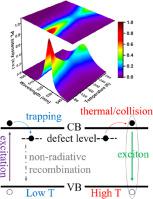当前位置:
X-MOL 学术
›
Mater. Today Phys.
›
论文详情
Our official English website, www.x-mol.net, welcomes your feedback! (Note: you will need to create a separate account there.)
Temperature Dependent Optical Characteristics of All-Inorganic CsPbBr3 Nanocrystals Film
Materials Today Physics ( IF 11.5 ) Pub Date : 2020-12-01 , DOI: 10.1016/j.mtphys.2020.100259 X.Y. Zhang , G.T. Pang , G.C. Xing , R. Chen
Materials Today Physics ( IF 11.5 ) Pub Date : 2020-12-01 , DOI: 10.1016/j.mtphys.2020.100259 X.Y. Zhang , G.T. Pang , G.C. Xing , R. Chen

|
Abstract As one of the most promising optoelectronic materials in recent years, colloidal all-inorganic lead halide perovskite nanocrystals (NCs) have become a research focus. An in-depth understanding of electron behavior in the material is essential for advanced device application. Here, temperature-dependent photoluminescence (PL) spectroscopy is employed to study the optical properties of CsPbBr3 NCs film. It is found that the PL intensity decreased with temperature below 200 K, while reverse trend has been observed with temperature above 200 K. The mechanism of the PL unusual quenching phenomenon is attributed to surface states of NCs, which leads to non-radiative recombination of electrons at low temperatures. Above the critical temperature, electrons will escape from the defect level and participate in radiative recombination, which give rise to the enhanced emission. The model is further verified by comparison with nanoplatelets, surface passivation, as well as temperature-dependent PL decay experiments.
中文翻译:

全无机 CsPbBr3 纳米晶薄膜的温度相关光学特性
摘要 作为近年来最有前途的光电材料之一,胶体全无机卤化铅钙钛矿纳米晶(NCs)已成为研究热点。深入了解材料中的电子行为对于先进的设备应用至关重要。在这里,温度相关的光致发光 (PL) 光谱被用来研究 CsPbBr3 NCs 薄膜的光学特性。发现PL强度随着温度低于200 K而下降,而在温度高于200 K时观察到相反的趋势。PL异常猝灭现象的机制归因于NCs的表面状态,导致非辐射复合低温下的电子。高于临界温度,电子将从缺陷能级逃逸并参与辐射复合,这导致增强的发射。通过与纳米血小板、表面钝化以及温度相关的 PL 衰减实验进行比较,进一步验证了该模型。
更新日期:2020-12-01
中文翻译:

全无机 CsPbBr3 纳米晶薄膜的温度相关光学特性
摘要 作为近年来最有前途的光电材料之一,胶体全无机卤化铅钙钛矿纳米晶(NCs)已成为研究热点。深入了解材料中的电子行为对于先进的设备应用至关重要。在这里,温度相关的光致发光 (PL) 光谱被用来研究 CsPbBr3 NCs 薄膜的光学特性。发现PL强度随着温度低于200 K而下降,而在温度高于200 K时观察到相反的趋势。PL异常猝灭现象的机制归因于NCs的表面状态,导致非辐射复合低温下的电子。高于临界温度,电子将从缺陷能级逃逸并参与辐射复合,这导致增强的发射。通过与纳米血小板、表面钝化以及温度相关的 PL 衰减实验进行比较,进一步验证了该模型。



























 京公网安备 11010802027423号
京公网安备 11010802027423号